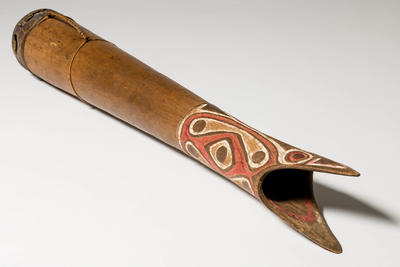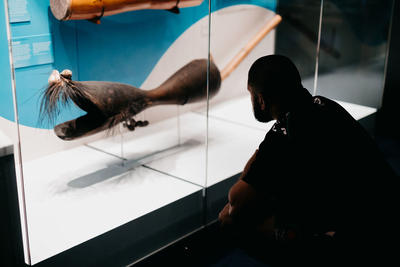Drum (warupa)
Country
Papua New Guinea
State/Province
Gulf of Papua New Guinea
See full details
Object detail
Description
Handle is carved, but is made of reed and is movable. Drum is very light, and only decorated on the bottom quarter. Designs are circular and curved, white and red. The bottom of the drum is carved into two points, resembling an open bird's mouth. Membrane is varanus indicus (mangrove monitor), and has 7 lumps of resin or beeswax on it.
Classification
MUSICAL INSTRUMENTS Percussion drum
Maker
Measurements
L973 x W153mm
Media/Materials description
Indeterminate (Natural Resins & Waxes)
Indeterminate (Woods)
Vegetable Fibre (Cordage)
Skin (Animal/Human Remains)
Other Art Surface (Art Work Surfaces)
Indeterminate (Woods)
Vegetable Fibre (Cordage)
Skin (Animal/Human Remains)
Other Art Surface (Art Work Surfaces)
History and use
Different cultural groups often bonded through ritual, ceremony and dance, so objects associated with these practices became significant trade items. Drums were one of the most important objects exchanged for ceremonial use. Torres Strait Islander people often acquired drums from New Guinea and, even today, the drums used in the Torres Strait are commonly sourced from New Guinea.
Drums are made from a hollowed-out single piece of wood. The tympanum - the skin end of the drum - could be covered with snake, lizard or wallaby skin. Lizard was the most common.
This shark mouth drum from Papua New Guinea is called warupa in Kiwai language. It is part of the extensive Charles and Kati Marson musical instrument held by Queensland Museum.
This item was most recently on display in the exhibition 'Connections across the Coral Sea: A story of movement' at Museum of Tropical Queensland (2021-2022) and Queensland Museum (2022-2023).
Drums are made from a hollowed-out single piece of wood. The tympanum - the skin end of the drum - could be covered with snake, lizard or wallaby skin. Lizard was the most common.
This shark mouth drum from Papua New Guinea is called warupa in Kiwai language. It is part of the extensive Charles and Kati Marson musical instrument held by Queensland Museum.
This item was most recently on display in the exhibition 'Connections across the Coral Sea: A story of movement' at Museum of Tropical Queensland (2021-2022) and Queensland Museum (2022-2023).
Registration number
E17826




